Tricky Vocabulary
This vocabulary test felt like 8th-grade level for the first 15 questions. I was sure I was going to ace it. Then, sure enough, I got two wrong. So, 23 out of 25.
Tricky Vocabulary
This vocabulary test felt like 8th-grade level for the first 15 questions. I was sure I was going to ace it. Then, sure enough, I got two wrong. So, 23 out of 25.
From TA: “Thank you for posting the link to the climate change movie in the April 3 issue…”
“I have been a climate skeptic for many years…. My gut told me that a planet that has been around for billions of years has seen huge fluctuations over that time that had to have been worse than what we’re seeing today. And life survived. This movie gave me more resources to inspect the ‘other side’ of the climate debate. It’s frightening how scientists like those in the film have been labeled as heretics, and that the same culture was at work during COVID to limit debate against doctors and scientists of equally high regard.”
Coming in the Next Issue!
A Fact About Real Estate Your Broker Doesn’t Want You to Know
Watch this short clip. It’s a teaser for some sort of information product – but what these two men are referring to is probably the most important secret in selling houses. I’ll tell you what it is, and how to use it to your advantage, in next week’s main issue.
The COVID-19 Cover-Up:
It Wasn’t Just That “They Got It Wrong” –
They Knew It Was Wrong and Lied Anyway, Part I
He is smart, well-educated, and generally open-minded. How could he be so ignorant of something as important as the facts about COVID-19?
He hadn’t, for example, heard or read about any of the reported side effects of the mRNA vaccines. He thought they had all been tested and were safe. And when I gave him some of the facts, he was visibly shocked. Not by what I was telling him, but that I, someone he thought of as smart, well-educated, and open-minded, could be spouting what to him were long-ago-disproven conspiracy theories.
He could not believe, he said, that prominent people in the NIH, AMA, CDC, or any other governmental or quasi-governmental health organization would promote ideas about COVID or the COVID vaccines that were untrue. He felt the same way about representatives of the pharmaceutical companies and the reporters and talking heads that covered the health beat for the major media.
It was not just this conversation, but several dozen with people I admire that prompted my first attempt to document the misinformation we were being fed about COVID and our government’s response to the pandemic – a series of essays that began with the Nov. 29, 2022 issue of this blog and continued through much of 2023. It covered all the major concerns and questions that were widely misunderstood back then and even today. Misconceptions that have since been all but admitted to by the people that promoted them, including the NIH, the AMA, the CDC, and the politicians and mainstream media that propagated them.
I planned to publish one final essay about COVID that would lay out all the facts and debunk all the myths. But as I plodded along, collecting, vetting, and cross-checking the new studies and essays and articles that continued to come in, I realized that it was turning into a book that would be, realistically speaking, published a year or two from now. And that, by then, my book would be competing with a half-dozen similar books written by better-known and more credentialed writers.
So, instead, I’m going to treat this effort as a multi-part project.
In each part, I’m going to focus on one “scientific fact” about COVID that we now know was false. I want to prove to you that, in some cases, the propagators of these falsehoods knew they were false when they said them. Perhaps worse, they knew that what they were doing could drive wrongheaded and even dangerous public mandates. And all of it was aided and abetted by the media, whose primary value to democracies is to courageously and consistently question the policies and practices of big government and big business.
I’m going to try to cover all the major issues – the misinformation and disinformation that began within days after it became known that a new strain of the coronavirus, COVID-19, had made its way into the US and was spreading quickly. And I’m going to start with the first piece of misinformation I came across when this whole craziness began: the claim that COVID-19 had a scarily high mortality rate – as high as 10% to 15%.
Why Did They Lie About the Mortality Rate?
COVID was declared a pandemic by the WHO on March 11, 2020. At the beginning, there was scant reliable data about the virus. But there were some early estimates by a half-dozen or so researchers indicating that it could be at least 10 times more contagious than other coronaviruses. The number that popped for me concerned the virus’s lethality.
If those early estimates of a 10% to 15% mortality rate were correct, we were looking at a pandemic that would have been more deadly than AIDs, which killed about 40 million, and perhaps even rivaling the Black Death of the 15th century that killed somewhere between 75 million and 200 million.
No wonder Anthony Fauci and other virologists and infectious disease specialists were alarmed!
In the first essay I wrote on the subject, I said that it didn’t seem possible that the mortality rate was anywhere near as high as the estimates because of other things the scientific community knew at the time. Chief among them was the already established fact that a significant percentage of people that came down with COVID-19 had mild, flu-like symptoms or were entirely asymptomatic.
Remember, this was at the very beginning of the pandemic, when few people were aware of what symptoms to look for. And even if they knew what to look for, and had the symptoms, it was difficult to get tested. The availability of test kits and testing facilities was extremely limited. So, many people with mild or no symptoms weren’t getting tested.
For me, this was a red flag. Because to calculate the mortality rate of any disease, you must compare the number of people that have it to the number of people that die from it. And nobody back then had any idea what percentage of the population had actually contracted COVID-19.
So those early analysts were making a serious statistical mistake – one that should have been recognized immediately. (It’s so big and obvious, it has a name. It’s called the denominator error.) It should have been recognized by the analysts themselves that came up with that crazily high mortality rate in the first place. And then by scientists at the NIH and CDC that were working on the virus. And, finally, by any media person with a 100+ IQ who reported the numbers to the public.
I had guesstimated – based mostly on what I knew about how difficult it was to get a test and what I’d had heard about how many people had mild-to-no symptoms – that the denominator they were using was wrong by a factor of 10. Maybe more.
As it turned out, I was right.
As more and more people got tested (thus increasing the size of the denominator), the official mortality estimates dropped from 10% to 6%, and then to 3%, where they stayed for a while. But by the end of 2021, they were down to 1%, and then down to 0.5% by the end of 2022.
In other words, those earliest estimates were wrong by a multiple of 20!
Now, you could still argue (as many COVID Conspiracy Propogandists still do) that the 0.5% figure is still much higher than the mortality rate of the common flu (about 0.01%). But to do that, you would have to ignore another monstrous mistake. I’m talking about the fact that the CDC and many other governmental health organizations tracking COVID deaths had, at the beginning of the pandemic, mandated that hospitals designate any patient that died with COVID as having died from COVID.
This is so mind-bendingly stupid that, after three years of following the research and writing about it, I am astonished that the practice continues today.
Think about it. An obese, diabetic, 81-year-old man is hospitalized and diagnosed with Stage 4 lung cancer. On admittance, he is given a COVID test (which is still required by the CDC), and he tests positive. While the doctors at the hospital perform lung surgery to try to extend his life, he dies. But in recording the cause of his death, the hospital must categorize it as due to COVID-19.
Even if a young man is rushed to the hospital after being shot in the heart, he is given a COVID test when he’s admitted. And if that test happens to be positive and he dies, his death will be officially attributed to COVID.
So now you must ask yourself: If hospitals were allowed to make reasonable diagnoses, what percentage of those that died with COVID had, in fact, died from other causes? Considering how widely spread COVID was in 2021 and 2022, my guess is that it was 20%, at most.
And if that proves to be true, the actual mortality rate of COVID is less than one-tenth of one percent. In other words, it might be about the same as or lower than the mortality rate of the common flu!
Those are the facts as I’ve come to understand them. If anything I’ve said above is wrong and you have the facts to prove it, please let me know so I can make a correction.
But please don’t write to say:
“Okay, the early scientists and the media that followed them got it wrong. But they did the best they could, given what they knew at the time. That was then and this is now. Let’s move on.”
That is, in fact, the narrative that the Medical-Industrial Complex has been trying out. And it may apply to some of what they told us that has since been proven false. But not in this case. The misinformation they handed out about the mortality rate of COVID-19 was based on logic and arithmetic that was so obviously wrong that those that issued and repeated it were guilty of either astonishing ignorance or purposeful deception.
And what makes it so much scarier is that the bogus numbers were accepted without so much as a second thought by the mainstream media and all but a tiny fraction of professionals, some of whom lost their licenses as a punishment for pointing out the obvious truth.
Finally, remember this: This was the first of a series of falsehoods about COVID perpetrated by the Medical-Industrial Complex and promoted by the mainstream media all over the world that did massive economic, educational, social, and psychological damage to millions of people. The economic cost alone may have amounted to nearly a trillion dollars!
And that’s to say nothing of the massive cost in terms of human life that is only beginning to be assessed. I’m talking, in particular, about the vaccines. Not just about the already proven correlations between the vaccines and their temporary side effects, but also about the growing evidence that they may have been the cause of many deaths.
That last claim is still being dismissed as a lunatic “conspiracy theory.” But before I’m finished with this series of Special Issues, it, too, might be proven to be true. A grim possibility.
Stay tuned.

A Century of Masterpieces Brought Together by One Passionate Collector
I’ve always loved reading about wealthy US businessmen who, during the gilded age of American Capitalism, assembled massive collections of art and then bequeathed them for the world to enjoy after their death. I’m thinking of William Vanderbilt, Henry Clay Frick, Andrew Carnegie (all in NYC), and William Walters (in Baltimore). I’m drawn to their stories because each one has two parts: how they amassed such large fortunes, and how they went about building their collections.

Joseph Hirshhorn
Smithsonian Magazine recently published this piece about Joseph Hirshhorn, who came to America from Latvia, broke and barely speaking English, and became one of the preeminent financiers of his time.
His collection is housed at the Hirshhorn Museum in Washington, DC, and the museum is presenting an exhibition (“Revolutions: Art from the Hirshhorn Collection, 1860 to 1960”) of some of the best of his pieces. It includes 208 artworks in the museum’s permanent collection by 117 artists (Francis Bacon, Jean Dubuffet, Lee Krasner, Wifredo Lam, Jacob Lawrence, Georgia O’Keeffe, Jackson Pollock…) made during 100 turbulent and energetic years.
The show runs until April 20. I’m going to get up there and see it before it closes, even if that means going up there and back on the same day.

The Hirshhorn Museum in Washington, DC

New York City: Time to Sell?
There is reason to believe that the current burden of the migrants taking advantage of New York City’s sanctuary city status may bankrupt it in the next 12 to 24 months.
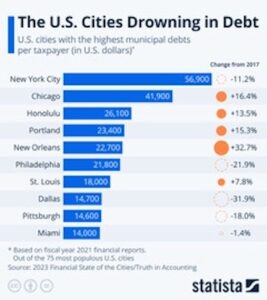
The city’s current debt is $132 billion. And yet, Mayor Adams and other city officials are planning on spending a lot more between now and the end of 2025 to pay for the housing, feeding, clothing, and other needs of this additional population.
The city already provides undocumented immigrants with Medicaid and the full range of welfare services for the first seven years of their time spent in the city. City officials believe they will spend $12 billion by the end of the 2025 fiscal year on this alone.
And now they are working on the idea of giving the migrants $350 a week via prepaid debit cards that are supposed to be used to purchase food and supplies for babies. It’s a pilot program that will be tested on 460 families and will cost the city $600,000 a month, or $7.2 million in the first year. But as best as I can ascertain, since 2022, NYC’s migrant population has grown from about 560,000 to about 800,000. And if my arithmetic is right, that means the city would eventually have to come up with an extra $3 billion in taxes to expand the program.
On top of all that, they have a serious problem with office buildings being underoccupied since COVID that has been costing the city billions of dollars a year in lost real estate tax income.
Based on everything I’ve read, I’d not be surprised to see the city’s debt top $200 billion within the next few years.
The only way for Mayor Adams and city officials to try to avoid that would be to drastically increase taxes even more than they’ve already been doing – a tactic that has backfired, with wealthy residents and large, tax-paying companies beginning to relocate out of the city and into less costly municipalities.
If I owned property in NYC, I’d be looking to sell it now.
Chart of the Week: Time for Non-US Stocks?
This week, Sean looks at the US stock market and highlights how expensive US stocks have become. (I’ve had conversations about this with several of the best analysts at The Agora Companies, which publishes dozens of economic, wealth, and financial advisories.)
From a value investing perspective, many US stocks, especially the sort of stocks we hold in the Legacy Portfolio are expensive – at a level that, like Sean, I’d be reluctant to buy more of them.
US stocks represent the majority of my investment in stocks, but stocks represent only about 20% of my wealth portfolio. Much of the rest is comprised of hard assets, real estate, and direct ownership of businesses, some of which are overseas. So, that gives my overall wealth portfolio some “anti-fragility.” If your wealth is primarily in US stocks, you should heed Sean’s warning today.
As US stocks inch ever higher, I find myself less interested in them.
I do not wish to overpay for something that, by any valuation measure, seems so unattractive.
This has led me to seek opportunities in gold and bonds. Now, I am looking at emerging markets.
Global markets excluding the US stock market have outperformed the US in five of the last seven decades.
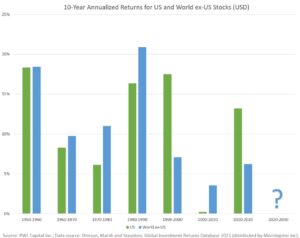
It raises some questions: Why should this decade be different?
Many other investors are starting to ask the same thing.
According to analysts from Bank of America, the shift into emerging market and eurozone equities has been remarkable, with movement into non-US stocks the highest it’s been in seven years.
The last time we saw US stock valuations this high, in the year 2000, non-US stocks proceeded to outperform US stocks in seven of the following 10 years.
This is cause for concern because, simply, most American investors, especially index investors, believe they have a well-diversified portfolio. Yet most of them do not hold non-US stocks.
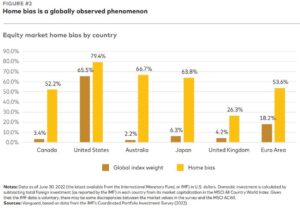
Having international assets, like real estate, can help hedge against currency fluctuations. They also allow investors to gain exposure to shifting growth trends.
The most exciting of those growth trends seem, to me, to be in South America, Central America, and Japan. (Though I am keeping an eye on Europe.)
Western Latin countries are benefitting heavily from the trend of nearshoring, where US firms are relocating manufacturing and operations to nearby countries.
And Japan is starting to see growth again after decades of stagnation.
One thing I will be doing in the coming months is looking for a non-US stock to add to the Legacy Portfolio. In July, I will be revealing what I discover on a stage in Tokyo.
But investors should consider shifting about 30% of their portfolio to non-US assets, like international stocks, now.
That might involve taking some gains on US growth stocks and moving them into non-US assets. Or it might simply involve buying non-US assets with your dividends or any new contributions you make to your investment portfolios.
– Sean MacIntyre
Check out Sean’s YouTube channel here.
Conspiracy Watch

Was the Bridge Collapse Sabotage?
After a cargo ship took down the Francis Scott Key bridge in Twin Tower fashion last week, I was not entirely surprised to learn that some people wondered if it was a planned event. I even read a few pieces that got me wondering. But then, thanks to GM, I read this take on what happened that was written by a certified master helmsman with lots of port transit time. I found it convincing:
“The ship in question is the MV Dali. The Dali has a fixed pitch prop, meaning the ship cannot go in reverse. She has an electric bow thruster, but that only really works at slow speeds and requires electrical power.
“The videos show the ship losing power and engines as it approaches the bridge. When the power goes out on a ship like that, the hydraulics that control the rudder stop working.
“After losing power, the helmsman likely turned the wheel all the way over to starboard in a futile effort to steer as the ship was drifting out of alignment. The rudders did not respond due to the power-outage. Then suddenly the engine (or auxiliary generator) kicks back on, which is the cause of the black smoke you see. Once the engine kicks back on, the power to the hydraulics is restored and the rudder immediately swings hard to starboard because the wheel is already turned over to that position. It would have taken the helmsman a few seconds to realize what was happening as rudder authority suddenly returns.
“A second ill-timed power-outage seals the fate, leaving the rudders locked hard to starboard just a few seconds too long.
“You can see him try to swing the rudder back over to the port side once he realizes the rudders are working again, but by then it is too late. The rudders on those ships are slow to respond. It can take over 10 seconds for the rudders to swing all the way over from one side to the other.
“I’ve had power-outages like this happen on a warship at sea with far more redundancy than this cargo ship has. Things like this can happen. Even with backup generators running, managing the electrical load on a ship like this is complex. It would have taken the engineers some time to figure out how to address an outage. As you can see from the video, the outages did not last long. They just happened at the worst possible time.
“There is no conspiracy.
“I would need to see some proof of sabotage before I believed this was planned. Killing the power also means killing the ability to steer. If the ship can’t be steered, there’s no way to intentionally aim it at the pier.
“I also see lots of questions about anchors. Anchors need to be manned. They typically can’t just be dropped by the push of a button. Further, it’s unlikely that even if they did have the anchors manned and managed to drop them that it would have managed to stop the ship in time. I doubt the captain even thought about it. I’m sure he was more concerned about keeping the ship on course. This all happens in just seconds. It’s easy to Monday-morning-quarterback this.”
Health Watch

I Was Way Ahead of My Peers…
When I was in my mid-forties and most of my friends and colleagues were wearing glasses, I wasn’t. I felt proud of that and mentioned it to my doctor.
“You are in a very small club,” he said. “More than 90% of people your age are already using glasses.”
“Does that mean I might never need them?” I asked.
“No,” he said smiling. “You’ll be wearing glasses in about 12 to 18 months.”
That shocked me. But this graphic on eyesight (and hearing) made it easier to understand.
Authentic Autism, or Aspirational Asperger’s?
From Steven Tucker, writing in Taki’s Magazine:
“Apparently, the current psychological condition du jour is autism, according to a new report from a pair of London clinicians… which warns that, since 1998, there has been a ninefold increase in autism diagnoses across the UK.
“Do many such new patients genuinely have autism, however, or have they just been groomed to think they have, thereby stealing away scarce medical resources from those genuine sufferers who actually need it?”
Read more here.
Trends in Wokeness

The Trump Camp and the White House Clash Over… Now What?
In 2021, Joe Biden proclaimed March 31 “Transgender Day of Visibility.” Because the date unfortunately overlapped with Easter Sunday in 2024, he is facing criticism from Donald Trump’s campaign and religious conservatives for this “years-long assault on the Christian faith.” Click here.
Political Tribes: Group Instinct and the Fate of Nations
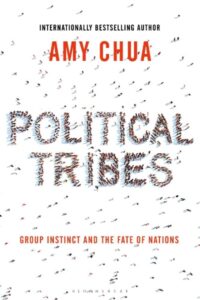
By Amy Chua
304 pages
First edition Feb. 20, 2018
This is the second of two Amy Chua books recommended to me by SL. The first, The Triple Package, which I reviewed here, was about why some immigrants to the US do much better than others in terms of income, education, and even health. As I mentioned in that review, I was interested in her argument because it overlaps with my thesis in a book I’m writing (working title Wealth Culture), which is about the cultural characteristics of immigrant groups that always seem to rise to the highest rungs of wealth and education wherever they go.
I like Political Tribes for a different reason: It presents a very convincing explanation for how the US managed to get itself in so many post-war proxy fights around the world, starting with Vietnam and then with Afghanistan, Pakistan, Iraq, and Venezuela.
Chua’s thesis is that the US’s foreign policy has always been focused on political and/or economic ideas such as dictatorships vs. democracies and Communism vs. Capitalism. Those sorts of notions are fodder for academics and politicians, she points out, but they are not the primary forces in how the rest of the world acts and reacts to economic, political, and social changes. Only by understanding the importance that culture plays in other countries can the US develop a foreign policy that works – both for the countries we get involved in and for ourselves.
Critical Reception
* “Chua sprints through her international material in a little over 100 pages before returning to the United States – which is where she gets stuck in a quagmire of her own making. What started out… as a shrewd assessment of our fractured political situation turns into a muddled argument about what Americans, mainly liberals, need to do next.” (New York Times)
* “Chua is no stranger to controversy, and her latest book is sure to provoke.” (Foreign Affairs)
* “A punchy book that advances a single idea with admirable clarity.” (The Times)
Climate the Movie: The Cold Truth
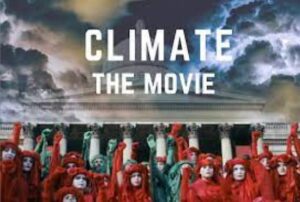
A documentary written and directed by Martin Durkin
Released March 23, 2023
Watch Time: 1 hr, 20 min
In addition to providing an impressive fact-based counter-argument to the dominant narrative about this high profile and hotly debated subject, Climate the Movie takes a look behind the politics and the science to reveal a vast and interwoven complex of businesses and special interest groups that together comprise a trillion-dollar industry.
What I Liked About It
It felt serious and sober – as close to trustworthy as an argument can sound about such a politicized issue.
By providing a longer-term perspective on climate change, the film demonstrates, quite convincingly, that, far from facing extinction from global warming, the globe is very gradually recovering from a multimillion-year cold spell. And while cold spells like this typically mean less life and less growth, warming is generally a good thing in terms of expanding the number of plants and animals on Earth.
There are also lots of interesting little nuggets of information that explain why the basic facts about climate change are in dispute.
The people behind Climate the Movie are asking viewers to share it… and are making it very easy to do. You can watch the entire thing here.
Who Says Fat Guys Can’t Fight!

Roy Nelson is a big guy, but most of his weight is around his waist. When he began his career as an MMA contender, he came to the arena as a fat guy who had a powerful overhand right. But none of the experts thought he had a chance of surviving three five-minute rounds of fighting, let alone become one of the most dominant heavyweight champions in UFC history, knocking out or submitting at least a half-dozen of the all-time greatest UFC champions. Click here.
What Some College Administrators Understand That (a Lot of) Wonks Don’t

Freddie deBoer (my favorite Communist influencer) on why some of the current thinking by college career advisors is wrong-headed. As always, I agree with 80% of what he says. Click here.